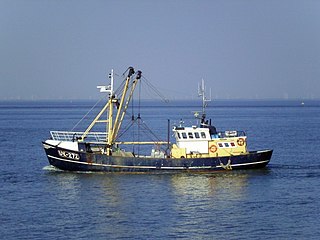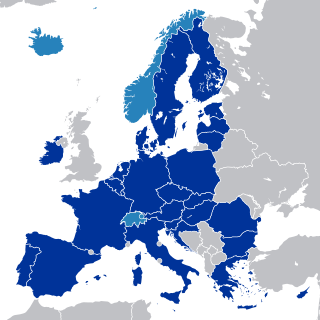Related Research Articles

The European Court of Justice (ECJ), formally just the Court of Justice, is the supreme court of the European Union in matters of European Union law. As a part of the Court of Justice of the European Union, it is tasked with interpreting EU law and ensuring its uniform application across all EU member states under Article 263 of the Treaty of the Functioning of the European Union (TFEU).

Eur-Lex is an official website of European Union law and other public documents of the European Union (EU), published in 24 official languages of the EU. The Official Journal (OJ) of the European Union is also published on EUR-Lex. Users can access EUR-Lex free of charge and also register for a free account, which offers extra features.

In the European Union, competition law promotes the maintenance of competition within the European Single Market by regulating anti-competitive conduct by companies to ensure that they do not create cartels and monopolies that would damage the interests of society.
In European Union law, direct effect is the principle that Union law may, if appropriately framed, confer rights on individuals which the courts of member states of the European Union are bound to recognise and enforce.

R v Secretary of State for Transport was a judicial review case taken against the United Kingdom government by a company of Spanish fishermen who claimed that the United Kingdom had breached European Union law by requiring ships to have a majority of British owners if they were to be registered in the UK. The case produced a number of significant judgements on British constitutional law, and was the first time that courts held that they had power to restrain the application of an Act of Parliament pending trial and ultimately to disapply that Act when it was found to be contrary to EU law.

European Union citizenship is afforded to all nationals of member states of the European Union (EU). It was formally created with the adoption of the 1992 Maastricht Treaty, at the same time as the creation of the EU. EU citizenship is additional to, as it does not replace, national citizenship. It affords EU citizens with rights, freedoms and legal protections available under EU law.

The European single market, also known as the European internal market or the European common market, is the single market comprising mainly the 27 member states of the European Union (EU). With certain exceptions, it also comprises Iceland, Liechtenstein, Norway, and Switzerland. The single market seeks to guarantee the free movement of goods, capital, services, and people, known collectively as the "four freedoms". This is achieved through common rules and standards that all participating states are legally committed to follow.
Flaminio Costa v ENEL (1964) Case 6/64 was a landmark decision of the European Court of Justice which established the primacy of European Union law over the laws of its member states.
Van Gend en Loos v Nederlandse Administratie der Belastingen (1963) Case 26/62 was a landmark case of the European Court of Justice which established that provisions of the Treaty Establishing the European Economic Community were capable of creating legal rights which could be enforced by both natural and legal persons before the courts of the Community's member states. This is now called the principle of direct effect. The case is acknowledged as being one of the most important, and possibly the most famous development of European Union law.

The primacy of European Union law is a legal principle establishing precedence of European Union law over conflicting national laws of EU member states.
Van Duyn v Home Office (1974) C-41/74 was a case of the European Court of Justice concerning the free movement of workers between member states.
Metock v Minister for Justice, Equality and Law Reform (2008) C-127/08 is a European Union law case, significant in Ireland and Denmark, on the Citizens Rights Directive and family unification rules for migrant citizens. Citizenship of the European Union was established by Article 20 of the Treaty on the functioning of the European Union (TFEU) and the Citizenship Directive 2004/38 elaborates the right of Union citizens and their family members to move and reside freely in the territory of a member state, consolidating previous Directives dealing with the right to move and reside within the European Community (EC).

The Court of Justice of the European Union (CJEU) is the judicial branch of the European Union (EU). Seated in the Kirchberg quarter of Luxembourg City, Luxembourg, this EU institution consists of two separate courts: the Court of Justice and the General Court. From 2005 to 2016, it also contained the Civil Service Tribunal. It has a sui generis court system, meaning 'of its own kind', and is a supranational institution.

The Treaty Establishing the European Stability Mechanism was signed by the member states of the eurozone to found the European Stability Mechanism (ESM), an international organisation located in Luxembourg, to act as a permanent source of financial assistance for member states in financial difficulty, with a maximum lending capacity of €500 billion. It replaced two earlier temporary EU funding programmes: the European Financial Stability Facility (EFSF) and the European Financial Stabilisation Mechanism (EFSM). All new bailouts of eurozone member states will be covered by ESM, while the EFSF and EFSM will continue to handle money transfers and program monitoring for bailouts previously approved for Ireland, Portugal and Greece.

Meca Medina and Majcen v Commission (2006) C-519/04 P was a landmark judgement in the European Court of Justice that established primacy of EU law over sports federations. The ruling concerned David Meca-Medina and Igor Majcen, long distance swimmers from Spain and Slovenia and their failed drugs test. The case was wide-reaching and important because it established the scope and nature that individual laws by sporting regulators, league operators and individual associations in Europe could impose their own rules and if they were in direct conflict with EU treaties, acquis or judgements by the European Courts of Justice.
Reference for a Preliminary Ruling in the Criminal Proceedings against Bernard Keck and Daniel Mithouard (1993) C-267/91 is an EU law case, concerning the conflict of law between a national legal system and European Union law. The Court found that "selling arrangements" did not constitute a measure having equivalent effect to a quantitative restriction on trade between Member States of the European Community, as it was then. As a result, the 'discrimination test' was introduced to identify such selling arrangements.
Opinion 2/13 (2014) is an EU law case determined by the European Court of Justice, concerning the accession of the European Union to the European Convention on Human Rights, and more generally the relationship between the European Court of Justice and European Court of Human Rights.
Unión de Pequeños Agricultores v Council of the European Union (2002) C-50/00 P is an EU law case, concerning a judicial review of a regulation adopted by the European Union. In this case, the European Court of Justice declined to accept the preliminary opinion of the Advocate General, Francis Jacobs.
Srl CILFIT v Ministry of Health (1982) Case 283/81 is an EU law case, concerning preliminary references to the Court of Justice of the European Union.
References
- Kari Joutsamo. The Role of Preliminary Rulings in the European Communities. Suomalainen Tiedeakatemia. 1979. Google.
- Henry Schermers. "Preliminary Rulings". Judicial Protection in the European Communities. Kluwer Law and Taxation Publishers Deventer. Third Edition. 1983. Reprinted. Springer. Part B of Part 1 of Chapter 4. Sections 554 to 625. Pages 350 to 397.
- Robert Schütze. "Preliminary Rulings" I and II: "General Aspects" and "Special Aspects". An Introduction to European Law. Third Edition. Oxford University Press. 2020. Pages 167 to 178. Cambridge University Press. 2012. Page 152 et seq.
- Broberg and Fenger on Preliminary References to the European Court of Justice. Oxford University Press. Third Edition. 2021. Preliminary References to the European Court of Justice. Second Edition. 2014.
- Jasper Krommendijk. National Courts and Preliminary References to the Court of Justice. (Elgar Studies in European Law and Policy). Edward Elgar. 2021. Google.
- Clelia Lacchi. Preliminary References to the Court of Justice of the European Union and Effective Judicial Protection. (Collection of the Faculty of Law, Economics and Finance of the University of Luxembourg). Éditions Larcier. 2020. Google.
- Woods and Watson. "The preliminary ruling procedure". Steiner & Woods EU Law. Eleventh Edition. Oxford University Press. 2012. Chapter 10. Pages 214 to 241.
- Trevor Hartley. "Preliminary References". The Foundations of European Union Law. Seventh Edition. Oxford University Press. 2010. Chapter 9. Pages 287 to 320.
- Marten Broberg. "Preliminary References as a Means for Enforcing EU Law". Jakab and Kochenov (eds). The Enforcement of EU Law and Values. 2017. Chapter 6. Pages 99 to 111.
- Witte, Mayoral, Jaremba, Wind and Podstawa (eds). National Courts and EU Law. Edward Elgar. 2016.
- Bruno de Witte. "The preliminary ruling dialogue: three types of questions posed by national courts". Chapter 2. Page 15 et seq.
- Urszula Jaremba. "Polish civil judiciary vis-a-vis the preliminary ruling procedure: in search of a mid-range theory". Chapter 4. Page 49 et seq.
- The Court of Justice of the European Union: Multidisciplinary Perspectives. (Swedish Studies in European Law, volume 10). Hart Publishing. Bloomsbury. 2018.
- Ulf Bernitz. "Preliminary Rulings to the CJEU and the Swedish Judiciary: Current Developments". Chapter 2. Pages 17 to 34.
- Anna Wallerman. "Referring Court Influence in the Preliminary Ruling Procedure: The Swedish Example". Chapter 9. Pages 153 to 170.
- ↑ Craig, Paul; de Búrca, Gráinne (2011). EU law: text, cases, and materials (5th ed.). Oxford: Oxford University Press. p. 482. ISBN 9780199576999.
- ↑ An "undertaking" in the EU is a company, partnership or business firm. See TFEU Arts 101 & 102.
- 1 2 Kokott, J., Opinion of Advocate General Kokott, ECJ case C-454/06 re: pressetext Nachrichtenagentur GmbH v Republik Österreich (Bund), delivered on 13 March 2008, accessed 15 February 2024
- ↑ Case 244/80, Pasquale Foglia v. Mariella Novello paragraph 18.
- ↑ Otherwise, an application to the ECJ may take a year or so before the question is answered.
- ↑ "European Communities Act 1972: Section 2", legislation.gov.uk , The National Archives, 1972 c. 68 (s. 2)
- ↑ "Civil Procedure Rules 1998, Part 68: References to the European Court". Archived from the original on 15 February 2012. Retrieved 23 February 2022.
- ↑ "Hoffmann-La Roche AG v Centrafarm Vertriebsgesellschaft Pharmazeutischer Erzeugnisse mbH". 24 May 1977. Retrieved 23 February 2022– via EUR-Lex.
- ↑ "Parfums Christian Dior SA and Parfums Christian Dior BV v Evora BV". 4 November 1997. Retrieved 23 February 2022– via EUR-Lex.
- ↑ Limante, Agne (2016). "Recent Developments in the Acte Clair Case Law of the EU Court of Justice: Towards a more Flexible Approach". JCMS: Journal of Common Market Studies. 54 (6): 1384–1397. doi:10.1111/jcms.12434. S2CID 148202834.
- ↑ Case C-24/92, Corbiau v Administration des Contributions, paragraph 15.
- ↑ "Dorsch Consult Ingenieurgesellschaft mbH v Bundesbaugesellschaft Berlin mbH". 17 September 1997. Retrieved 23 February 2022– via EUR-Lex.
- ↑ "Synetairismos Farmakopoion Aitolias & Akarnanias v GlaxoSmithKline plc and GlaxoSmithKline AEVE". 31 May 2005. Retrieved 23 February 2022– via EUR-Lex.
- ↑ "Rheinmühlen-Düsseldorf v Einfuhr- und Vorratsstelle für Getreide und Futtermittel". 12 February 1974. Retrieved 23 February 2022– via EUR-Lex.
- ↑ "Case 246/80, C. Broekmeulen v Huisarts Registratie Commissie". 6 October 1981. Retrieved 23 February 2022– via EUR-Lex.
- ↑ InfoCuria, Case C‑76/16, Ingsteel spol. s r. o. and Metrostav a.s. v Úrad pre verejné obstarávanie (Slovak Public Procurement Regulatory Authority), paragraph 50, delivered 13 July 2017, accessed 28 July 2023
- ↑ "The Protocol on Ireland/Northern Ireland Contents. Chapter 11: Implementation, application, supervision and enforcement, and other provisions (Articles 12, 13, 16, 17 and 19)". British Parliament. Retrieved 31 December 2020.
- ↑ "EUR-Lex". eur-lex.europa.eu. Retrieved 1 December 2016.